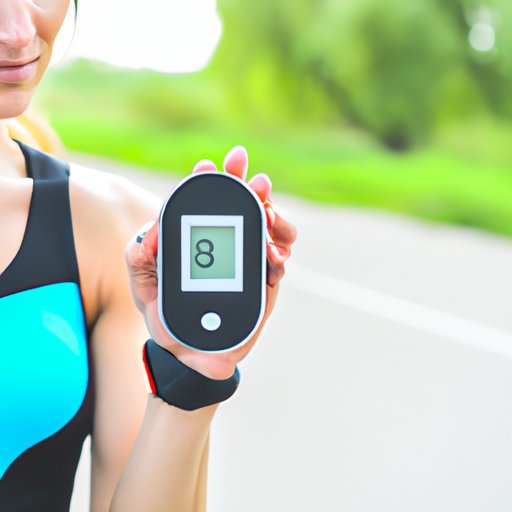
I. Introduction
Have you ever noticed your heart pounding faster and harder during a workout? This is a natural response to physical activity, and understanding why heart rate increases during exercise is essential for optimizing your fitness routine. Monitoring your heart rate can also help prevent injury and provide a gauge for the intensity of your workout. In this article, we will explore the science behind increased heart rate during exercise, the benefits it provides, and how to measure and monitor your heart rate during exercise. We will also discuss common misconceptions about heart rate and exercise, as well as potential risks associated with an elevated heart rate.
II. The Science behind Increased Heart Rate during Exercise
When you exercise, your heart rate increases to supply more oxygen and nutrients to your muscles. This is due to the physiological mechanisms responsible for elevated heart rate, which includes the release of epinephrine (adrenaline) and norepinephrine. These hormones increase heart rate and contractility, enabling the heart to pump more blood to the body’s tissues.
The sympathetic nervous system plays a crucial role in regulating heart rate during exercise. It stimulates the release of epinephrine and norepinephrine, which activate the cardiovascular system to support physical activity. The parasympathetic nervous system, on the other hand, slows down heart rate during rest and relaxation.
The type of exercise you engage in can also affect heart rate. Aerobic exercise, such as running or swimming, is known to increase heart rate more than resistance training or weightlifting.
III. The Benefits of an Increased Heart Rate during Exercise
An elevated heart rate during exercise brings a host of benefits for your overall health and fitness, including:
- Improved cardiovascular health: Regular exercise that elevates heart rate can reduce the risk of heart disease, stroke, and other chronic illnesses.
- Increased endurance: Regular aerobic exercise can improve your body’s ability to use oxygen, leading to better endurance and stamina.
- Calorie burning and weight loss: Physical activity that elevates heart rate burns more calories, making it an effective way to manage weight or lose weight.
- Reduced risk of chronic diseases: Regular exercise has been shown to lower the risk of type 2 diabetes, some types of cancer, and other chronic illnesses.

IV. How to Measure and Monitor Your Heart Rate during Exercise
Measuring and monitoring your heart rate during exercise is essential for optimizing your workout intensity and preventing injury. There are different methods of tracking heart rate, such as:
- Using a heart rate monitor: This can be in the form of a chest strap or wristwatch that measures heart rate in real-time.
- Taking your pulse: This involves counting the beats of your pulse for 15 seconds and multiplying by four to get the number of beats per minute.
It’s also important to calculate your target heart rate zone based on your age and fitness level. To do this, subtract your age from 220 to get your maximum heart rate, then multiply by 0.6 and 0.8 to determine your target heart rate zone.
Individualizing your exercise intensity based on heart rate is crucial, as everyone’s fitness level and goals are different. Keep in mind that your target heart rate zone is just a guide, and you should always listen to your body and adjust exercise intensity accordingly.
V. Tips for Optimizing Your Heart Rate during Exercise
To maximize the benefits of an increased heart rate during exercise, try incorporating these tips:
- Incorporating interval training or high-intensity bursts into your routine: This can help boost your heart rate and improve endurance.
- Varying types of exercise to challenge the heart and prevent boredom: Switching up your workouts can help keep your heart rate elevated and provide a more well-rounded fitness routine.
- Gradually increasing workout intensity: This can help prevent overexertion and injury while allowing your body to adapt to increased physical activity.
VI. Factors that Affect Heart Rate during Exercise
Several factors can affect heart rate during exercise, including:
- Age and fitness level: Older individuals and those with lower fitness levels may have a lower maximum heart rate and require a lower target heart rate zone.
- Hydration and nutrition: Dehydration and poor nutrition can affect heart rate, so it’s essential to stay well-hydrated and nourished before, during, and after exercise.
- Medications and health conditions: Certain medications and health conditions can affect heart rate during exercise, so it’s essential to consult with a healthcare professional before starting or changing an exercise routine.
- Environmental factors: Altitude, temperature, and humidity can all affect heart rate during exercise. Exercise at an altitude or in hot or humid conditions may require adjustments in intensity to prevent injury.
VII. The Potential Risks of an Elevated Heart Rate during Exercise
While an elevated heart rate during exercise is generally beneficial, there are potential risks associated with overexertion, including:
- Dehydration and electrolyte imbalances: Prolonged or intense exercise can cause sweating, leading to dehydration and electrolyte imbalances, which can cause muscle cramps or in severe cases, organ damage.
- Muscle strain and injury: Overexertion can lead to muscle strain or injury if not appropriately managed.
- Risk of heart attack in vulnerable individuals: While the risk is low, intense exercise can increase the risk of heart attack in individuals with underlying heart disease or other health conditions. It’s essential to consult with a healthcare professional before starting or changing an exercise routine if you have any health concerns.
VIII. Common Misconceptions about Heart Rate and Exercise
There are several misconceptions about heart rate and exercise that need to be addressed, including:
- The belief that a slower heart rate always indicates better fitness: While a slower resting heart rate may be correlated with good cardiovascular health, it’s not always an indicator of fitness levels. Factors such as age, medications, and health conditions can also affect heart rate.
- The importance of individualizing exercise intensity and monitoring heart rate: As mentioned earlier, everyone’s fitness level and goals are different, so it’s crucial to individualize exercise intensity based on heart rate and monitor it to prevent injury and optimize workout intensity.
- The importance of overall health and fitness rather than just heart rate alone: While measuring and monitoring your heart rate during exercise is essential, it’s only one aspect of overall health and fitness. Other factors such as strength, flexibility, and balance, should also be considered and addressed in your fitness routine.
IX. Conclusion
Increased heart rate during exercise is a natural response that brings numerous benefits for your overall health and fitness. Understanding and monitoring your heart rate during exercise is essential for optimizing your workout intensity and preventing injury. Remember to individualize your exercise routine based on your fitness level and goals, and consult with a healthcare professional before starting or changing an exercise routine if you have any health concerns. As with any aspect of fitness, consistency and patience is key.





